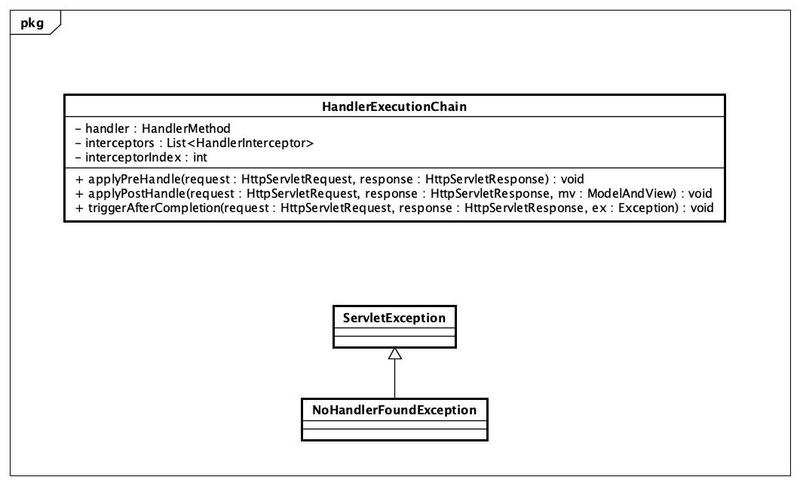本节我们开始来开发HandlerMapping接口中主要的方法getHandler,通过请求request找到需要执行Handler,涉及到的新类不多
6.1 开发步骤讲解
本节源代码的分支:handlerMapping-getHandler
HandlerExecutionChain
该类的主要包含了两个对象
- HandlerMethod: 根据request中的path找到匹配的
HandlerMethod,也就是控制器中的某个方法 List<HandlerInterceptor>: 根据request中的path找到所有对本次请求生效的HandlerInterceptor
三个方法:
- applyPreHandle: 执行所有拦截器的preHandle方法,如果preHandle返回的是false,那么就执行triggerAfterCompletion
- applyPostHandle: 执行所有拦截器的postHandle方法
- triggerAfterCompletion:
HandlerExecutionChain中还定义了一个变量interceptorIndex,当每执行一个HandlerInterceptor的preHandle方法后interceptorIndex的值就会被修改成当前执行拦截器的下标,triggerAfterCompletion中根据interceptorIndex记录的下标值反向执行拦截器的afterCompletion方法;
举例说明:假如有三个拦截器,第一个拦截器正常执行完成preHandle方法,在执行第二个拦截器的preHandle返回了false,那么当调用triggerAfterCompletion只会执行第一个拦截器的afterCompletion
完整代码如下:
public class HandlerExecutionChain {
private HandlerMethod handler;
private List<HandlerInterceptor> interceptors = new ArrayList<>();
private int interceptorIndex = -1;
public HandlerExecutionChain(HandlerMethod handler, List<HandlerInterceptor> interceptors) {
this.handler = handler;
if (!CollectionUtils.isEmpty(interceptors)) {
this.interceptors = interceptors;
}
}
public boolean applyPreHandle(HttpServletRequest request, HttpServletResponse response) throws Exception {
if (CollectionUtils.isEmpty(interceptors)) {
return true;
}
for (int i = 0; i < interceptors.size(); i++) {
HandlerInterceptor interceptor = interceptors.get(i);
if (!interceptor.preHandle(request, response, this.handler)) {
triggerAfterCompletion(request, response, null);
return false;
}
this.interceptorIndex = i;
}
return true;
}
public void applyPostHandle(HttpServletRequest request, HttpServletResponse response, ModelAndView mv) throws Exception {
if (CollectionUtils.isEmpty(interceptors)) {
return;
}
for (int i = interceptors.size() - 1; i >= 0; i--) {
HandlerInterceptor interceptor = interceptors.get(i);
interceptor.postHandle(request, response, this.handler, mv);
}
}
public void triggerAfterCompletion(HttpServletRequest request, HttpServletResponse response, Exception ex)
throws Exception {
if (CollectionUtils.isEmpty(interceptors)) {
return;
}
for (int i = this.interceptorIndex; i >= 0; i--) {
HandlerInterceptor interceptor = interceptors.get(i);
interceptor.afterCompletion(request, response, this.handler, ex);
}
}
public List<HandlerInterceptor> getInterceptors() {
return interceptors;
}
public HandlerMethod getHandler() {
return handler;
}
}NoHandlerFoundException
在通过HandlerMapping.getHandler获取对应request处理器的时候,可能会遇到写错了请求的路径导致找不到匹配的Handler情况,这个时候需要抛出指定的异常,方便我们后续处理,比如说跳转到错误页面
public class NoHandlerFoundException extends ServletException {
private String httpMethod;
private String requestURL;
public NoHandlerFoundException(HttpServletRequest request) {
this.httpMethod = request.getMethod();
this.requestURL = request.getRequestURL().toString();
}
public String getHttpMethod() {
return httpMethod;
}
public String getRequestURL() {
return requestURL;
}
}RequestMappingHandlerMapping.getHandler
- 我们需要先在
RequestMappingHandlerMapping中添加拦截器的代码,
private List<MappedInterceptor> interceptors = new ArrayList<>();
public void setInterceptors(List<MappedInterceptor> interceptors) {
this.interceptors = interceptors;
}为什么我们还需要在RequestMappingHandlerMapping保存拦截器的集合呢?与HandlerExecutionChain中拦截器的集合有什么区别?
RequestMappingHandlerMapping中拦截器的集合包含了容器中所有的拦截器,而HandlerExecutionChain中拦截器集合只包含了匹配请求path的拦截器RequestMappingHandlerMapping是获取Handler的工具,构建HandlerExecutionChain的过程中需要从所有拦截器中找到与本次请求匹配的拦截器,所以把所有拦截器的集合放到RequestMappingHandlerMapping中是合理的接下来我们看看
RequestMappingHandlerMapping.getHandler的具体实现
@Override
public HandlerExecutionChain getHandler(HttpServletRequest request) throws Exception {
String lookupPath = request.getRequestURI();
HandlerMethod handler = mappingRegistry.getHandlerMethodByPath(lookupPath);
if (Objects.isNull(handler)) {
throw new NoHandlerFoundException(request);
}
return createHandlerExecutionChain(lookupPath, handler);
}通过调用request.getRequestURI()获取到本次请求的path,然后根据path从MappingRegistry找到对应的HandlerMethod,如果找不到就抛出之前我们定义的异常NoHandlerFoundException;
private HandlerExecutionChain createHandlerExecutionChain(String lookupPath, HandlerMethod handler) {
List<HandlerInterceptor> interceptors = this.interceptors.stream()
.filter(mappedInterceptor -> mappedInterceptor.matches(lookupPath))
.collect(toList());
return new HandlerExecutionChain(handler, interceptors);
}从所有拦截器中过滤出匹配本次请求path的拦截器,然后创建HandlerExecutionChain对象。到此getHandler的功能开发完成
6.2 单元测试
我们开始写单元测试,本节的测试用例:
- 测试getHandler返回的HandlerExecutionChain数据是否正确: a) HandlerMethod中的bean是正确的Controller实例; b) interceptors是否是匹配请求的path
- 测试getHandler找不到Handler是否会抛出异常
NoHandlerFoundException - 同一个拦截器添加连个includePatterns,能正确匹配
接下来我们根据测试用例来编写测试代码:
建立两个拦截器TestHandlerInterceptor、Test2HandlerInterceptor, 一个控制器TestHandlerController
public class Test2HandlerInterceptor implements HandlerInterceptor {
@Override
public boolean preHandle(HttpServletRequest request, HttpServletResponse response, Object handler) throws Exception {
System.out.println("Test2HandlerInterceptor => preHandle");
return false;
}
@Override
public void postHandle(HttpServletRequest request, HttpServletResponse response, Object handler, ModelAndView modelAndView) throws Exception {
System.out.println("Test2HandlerInterceptor => postHandle");
}
@Override
public void afterCompletion(HttpServletRequest request, HttpServletResponse response, Object handler, Exception ex) throws Exception {
System.out.println("Test2HandlerInterceptor => afterCompletion");
}
}
public class TestHandlerInterceptor implements HandlerInterceptor {
@Override
public boolean preHandle(HttpServletRequest request, HttpServletResponse response, Object handler) throws Exception {
System.out.println("TestHandlerInterceptor => preHandle");
return true;
}
@Override
public void postHandle(HttpServletRequest request, HttpServletResponse response, Object handler, ModelAndView modelAndView) throws Exception {
System.out.println("TestHandlerInterceptor => postHandle");
}
@Override
public void afterCompletion(HttpServletRequest request, HttpServletResponse response, Object handler, Exception ex) throws Exception {
System.out.println("TestHandlerInterceptor => afterCompletion");
}
}
@Controller
public class TestHandlerController {
@RequestMapping(path = "/ex_test", method = RequestMethod.POST)
public void exTest() {
}
@RequestMapping(path = "/in_test", method = RequestMethod.POST)
public void inTest() {
}
@RequestMapping(path = "/in_test2", method = RequestMethod.POST)
public void inTest2() {
}
@RequestMapping(path = "/in_test3", method = RequestMethod.POST)
public void inTest3() {
}
}在AppConfig.java中配置 RequestMappingHandlerMapping ,配置拦截器,把拦截器集合放入到RequestMappingHandlerMapping中
@Bean
public RequestMappingHandlerMapping handlerMapping() {
InterceptorRegistry interceptorRegistry = new InterceptorRegistry();
TestHandlerInterceptor interceptor = new TestHandlerInterceptor();
interceptorRegistry.addInterceptor(interceptor)
.addExcludePatterns("/ex_test")
.addIncludePatterns("/in_test");
Test2HandlerInterceptor interceptor2 = new Test2HandlerInterceptor();
interceptorRegistry.addInterceptor(interceptor2)
.addIncludePatterns("/in_test2", "/in_test3");
RequestMappingHandlerMapping mapping = new RequestMappingHandlerMapping();
mapping.setInterceptors(interceptorRegistry.getMappedInterceptors());
return mapping;
}单元测试代码:
@Test
public void testGetHandler() throws Exception {
MockHttpServletRequest request = new MockHttpServletRequest();
//测试TestHandlerInterceptor拦截器生效
request.setRequestURI("/in_test");
HandlerExecutionChain executionChain = requestMappingHandlerMapping.getHandler(request);
HandlerMethod handlerMethod = executionChain.getHandler();
Assert.assertTrue(handlerMethod.getBean() instanceof TestHandlerController);
Assert.assertTrue(((MappedInterceptor) executionChain.getInterceptors().get(0)).getInterceptor()
instanceof TestHandlerInterceptor);
//测试TestHandlerInterceptor拦截器不生效
request.setRequestURI("/ex_test");
executionChain = requestMappingHandlerMapping.getHandler(request);
Assert.assertEquals(executionChain.getInterceptors().size(), 0);
//测试找不到Handler,抛出异常
request.setRequestURI("/in_test454545");
try {
requestMappingHandlerMapping.getHandler(request);
} catch (NoHandlerFoundException e) {
System.out.println("异常URL:" + e.getRequestURL());
}
//测试Test2HandlerInterceptor拦截器对in_test2、in_test3都生效
request.setRequestURI("/in_test2");
executionChain = requestMappingHandlerMapping.getHandler(request);
Assert.assertEquals(executionChain.getInterceptors().size(), 1);
Assert.assertTrue(((MappedInterceptor) executionChain.getInterceptors().get(0)).getInterceptor()
instanceof Test2HandlerInterceptor);
request.setRequestURI("/in_test3");
executionChain = requestMappingHandlerMapping.getHandler(request);
Assert.assertEquals(executionChain.getInterceptors().size(), 1);
Assert.assertTrue(((MappedInterceptor) executionChain.getInterceptors().get(0)).getInterceptor()
instanceof Test2HandlerInterceptor);
}运行结果如下:
6.3 总结
本节完成了获取Handler的开发,其中主要的对象是HandlerExecutionChain,它包含了具体执行业务逻辑的HandlerMethod以及匹配的拦截器;到此HandlerMapping的大部分开发工作都已完成,下一节我开始研发HandlerAdapter
6.4 延展
完成本节的开发后,大家可以对比着去看看SpringMVC中RequestMappingHandlerMapping的getHandler方法,提供的功能更加完善,比如:跨域配置CORS

